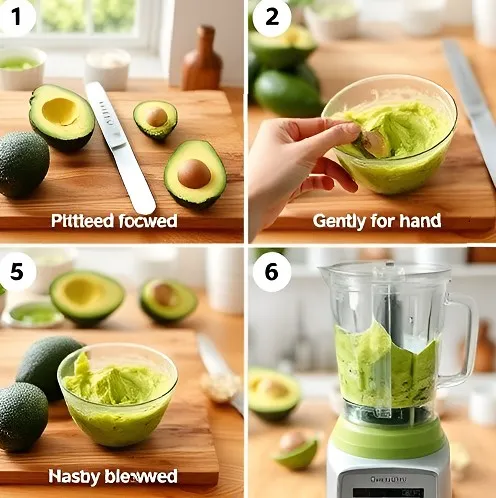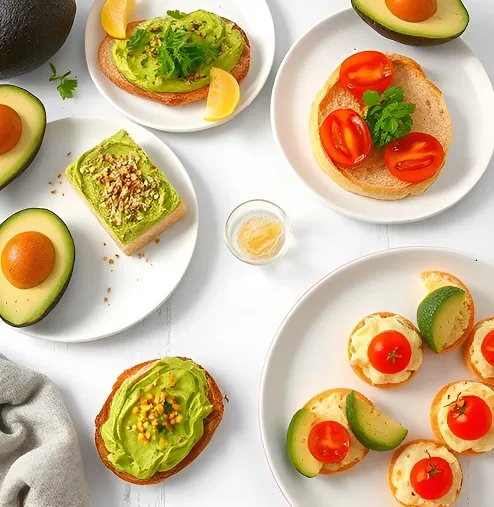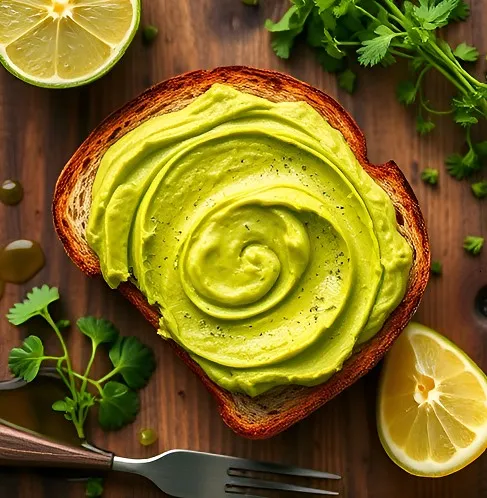Avocado spread has quickly become a kitchen staple for families and food enthusiasts worldwide. Its smooth, creamy texture and rich yet subtle flavor make it the perfect addition to everything from a hearty morning toast and energizing breakfast bagel to delightful snack platters and elegant appetizers. Whether you’re on a journey to enhance your meals or simply looking for a healthier alternative to processed spreads, this guide will walk you through everything you need to know about crafting your own avocado spread at home.
In today’s post, we dive into what makes avocado spread so irresistible and how you can become a kitchen wizard by creating a spread that is truly your own. We’ll cover not only the basics but also advanced tips that infuse your spread with personality and stack up its nutritional benefits. So, grab a ripe avocado and let’s transform your culinary routine!
What Is Avocado Spread?
At its core, avocado spread is a silky, edible blend crafted primarily from perfectly ripe avocados. Unlike traditional guacamole, which often features diced tomatoes, onions, and other chunky vegetables, avocado spread is refined to achieve a smooth, consistent texture that slathers easily over bread or crackers. The process of blending the fruit down emphasizes the natural creaminess and delicate flavor notes of avocado, making it a versatile base that invites further flavor customization.
What sets avocado spread apart from many other spreads is its balance of simplicity and flexibility. The mild flavor of the avocado provides an ideal backdrop for additional ingredients, whether you’re in the mood for something zesty with citrus and garlic, or richer with nutty tahini and a hint of olive oil. This adaptability, combined with avocados’ inherent health benefits, has made avocado spread one of the most popular condiments in modern kitchens.
The Story Behind the Spread
Avocados have been celebrated across diverse cultures for decades, if not centuries, thanks to their luscious texture and nutritional profile. While traditional guacamole has its roots in ancient Mesoamerican cuisine, the trend toward smoother, more modern avocado spreads is a nod to both contemporary eating habits and the drive for healthier, plant-based alternatives. Today, avocado spread is cherished not just for its taste but also for its versatility. It’s a healthful, visually appealing option that fits well with a variety of dietary lifestyles—from vegan and vegetarian diets to balanced, nutrient-rich meal plans.
The trend has been further amplified by social media and food bloggers who have transformed traditional recipes into visually stunning and uncomplicated spreads that look as good as they taste. This evolution has helped avocado spread cement itself as a reliable, innovative ingredient that can elevate any dish, whether for a quick snack or a gourmet experience.
Key Ingredients: The Building Blocks of Great Avocado Spread
Creating a phenomenal avocado spread starts with choosing high-quality ingredients. When you prepare your own spread, you have the freedom to source the best produce and add flavors that suit your taste. Understanding the role and quality of each ingredient is essential.

The Star of the Show: Ripe Avocados
Choosing the right avocado is paramount. Ripeness is the key—look for fruit that yields gently to pressure without being overly soft or mushy. A perfectly ripe avocado should feel firm yet delicately yielding when pressed with your finger. Its flesh should be a vibrant green with a buttery, smooth consistency. If you’re new to selecting avocados, try snagging a few from your local farmers’ market where freshness and quality are prioritized.
Citrus: Nature’s Preservative and Flavor Enhancer
A splash of lemon or lime juice is indispensable for a couple of reasons. First, it offers a subtle tang that elevates the spread’s flavor profile. Second, the natural acids in citrus play an important role in preventing oxidation. As soon as the avocado is exposed to air, it can begin browning. A generous squeeze of lemon or lime diminishes this process while contributing a refreshing brightness to the overall taste.
Salt and Garlic: Simple Flavors That Make a World of Difference
While some purists may enjoy the pure taste of avocado, a pinch of salt and a touch of garlic can heighten the spread’s natural flavor. Fresh garlic delivers a more intense and aromatic profile compared to its powdered counterpart, though both work well when added in moderation. It’s wise to start with a small amount of garlic and adjust as needed; after all, a good avocado spread should remain mellow and inviting.
Optional Enhancements: Personalizing Your Spread
What makes homemade avocado spread truly special is its customizability. You can experiment by tossing in other nutritional powerhouses and flavor boosters such as:
- Tahini: Introduces a nutty, rich layer that pairs wonderfully with the creamy texture of avocado.
- Fresh Herbs (Cilantro, Parsley, Basil): These not only add vibrant color but also infuse the spread with aromatic nuances.
- Red Pepper Flakes: For those who appreciate a gentle kick of heat, a pinch of red pepper flakes can add a surprising twist.
- Olive Oil: A drizzle of quality olive oil can enhance the spread’s creaminess and add a subtle richness that rounds out the flavors.
Each element is an opportunity to infuse your personality into the dish. Experiment with quantities and combinations to discover your perfect balance.
Essential Tools for a Smooth Process
Before you start blending, it’s important to have the right equipment on hand. The path to an impeccably smooth spread is as much about technique as it is about the right tools.
A Reliable Food Processor or High-Powered Blender
Investing in a good-quality food processor can make all the difference. These appliances ensure that all the ingredients blend evenly, achieving a consistently smooth texture that’s difficult to replicate with manual mashing. However, if you prefer a chunkier texture, you can opt to mash by hand with a fork in a mixing bowl. The key is to choose a method that aligns with your desired outcome.
Mixings Bowls and Measuring Tools
Precision is key when balancing flavors. Use sturdy mixing bowls to combine ingredients, and have measuring spoons or cups on hand to ensure accuracy. These tools are especially important when you’re venturing into advanced versions with additional spices and liquid elements.
Storage Solutions for Longevity
Since avocado spread is best enjoyed fresh, choose airtight containers for storage to slow down oxidation. A tight-fitting lid or a layer of plastic wrap pressed directly against the surface of the spread can help maintain its vibrant green color and fresh taste for as long as possible.
Step-by-Step: Crafting Your Perfect Avocado Spread
Creating avocado spread at home is a fun, engaging process—here’s a detailed walkthrough that covers every aspect from start to finish.
Step 1: Selecting and Preparing the Avocados
The journey begins with selecting the best fruit. Look for avocados that are sun-kissed in color and yield to a gentle press. Once selected, rinse them briefly under cool water to remove any surface dirt. Using a sharp knife, slice each avocado lengthwise around the seed. Twist the halves apart carefully, remove the pit with a gentle tap of your knife (or use a specialized tool for added safety), and then scoop the flesh into a bowl. The smoother your initial preparation, the more refined the final spread will be.

Step 2: Choosing Your Mashing Method
Once the avocado flesh is gathered, decide on your mashing method. A fork can give you a rustic, chunkier texture, which can provide delightful contrast in sandwiches or dips. When using manual mashing, add a dash of lemon or lime juice as you break down the fruit to help preserve its natural color and prevent oxidation. For a velvety, restaurant-quality spread, transfer the avocado to a food processor. Pulse gently until you achieve a silky consistency—be careful not to over-process, which can lead to a slightly too-liquefied texture.
Step 3: Combining the Flavors
With your avocado base prepared, it’s time to enhance it with complementary flavors. Slowly incorporate your freshly squeezed citrus juice and a pinch of salt. At this stage, consider adding minced garlic, being mindful of its potency. Add optional ingredients gradually. For example, if you’ve chosen to include tahini or olive oil, drizzle them in slowly while continuously blending. Tasting as you go is crucial; you want the flavors to come together harmoniously rather than overpower the inherent taste of the avocado.
Step 4: Adjusting the Texture and Taste
Your avocado spread should be treated as a living creation—one that evolves to meet your taste preferences. If you prefer a more robust texture, stop blending sooner to retain tiny avocado flecks. If you’re after complete smoothness, blend for a few extra seconds. Continue tasting and adjusting the seasoning with salt, garlic, or even a touch more lemon juice until it perfectly matches your palate. The beauty of a homemade recipe is its flexibility: unlike prepackaged products, every batch is unique and tailored to you.
Step 5: Final Presentation and Serving
Once your avocado spread reaches perfection, scoop it into a serving dish or store it in an airtight container. For immediate enjoyment, pair your spread with crispy toast, fresh veggies, or use it as a filling in wraps and sandwiches. Presentation can elevate the experience—sprinkle over finely chopped herbs, a dusting of paprika, or additional red pepper flakes for an inviting look that tempts your taste buds.

Mastering Customization and Fine-Tuning Your Flavor
One of the greatest advantages of making avocado spread at home is its potential for endless customization. Beyond the basic recipe, there are countless ways to modify your spread to align with changing tastes or to match specific meal themes.
Consider experimenting with different citrus fruits. While lemon and lime are traditional choices, some cooks find that a small amount of orange juice provides a surprising, sweet tang that rounds out the flavor profile beautifully. Alternatively, adding a spoonful of Greek yogurt can introduce extra creaminess along with a slight tang that complements the avocado wonderfully.
For those who enjoy a little heat, try infusing the spread with roasted jalapeños or a drizzle of sriracha. This alteration not only adds spice but also deepens the overall flavor complexity. Fresh herbs like basil or dill can transform the spread into a more sophisticated condiment, ideal for pairing with grilled meats or as part of a light summer salad.
The key is to approach customization with both creativity and a willingness to experiment. Always add new ingredients in small increments and allow the flavors to meld before deciding whether more is needed. The journey of finding your signature avocado spread can be as enriching as the final product itself.
Elevating Your Meals: Creative Serving Suggestions
A well-prepared avocado spread is not just a topping—it’s an invitation to explore culinary creativity in your everyday meals. Its versatility makes it an excellent addition to various recipes and presentations. Let’s explore some creative ways to incorporate your homemade avocado spread into your daily menu.
When it comes to breakfast and brunch, avocado toast has become a global phenomenon. Spread a generous layer of your creation on a slice of artisan bread, and top it with soft boiled eggs, microgreens, a sprinkle of chili flakes, or even a drizzle of quality olive oil to create texture and flavor contrast. Bagels offer another arena for creativity; replace your everyday cream cheese with avocado spread, and add slivers of tomato, red onion, or even a few capers to create a delightful morning ritual.
For lunch and dinner, consider using avocado spread as a healthier alternative to mayonnaise in sandwiches and wraps. It works especially well with lean proteins like turkey or grilled chicken, as well as robust veggie options like roasted bell peppers and spinach. Imagine a gourmet burger, where a dollop of smooth avocado spread replaces traditional condiments, adding moisture and an unexpected twist to every bite.
At parties or casual gatherings, avocado spread can shine as an appetizer or dip. Serve it alongside an assortment of crunchy raw vegetables—think carrots, cucumbers, and bell peppers—or paired with freshly baked pita or whole-grain crackers. A vibrant platter featuring avocado spread garnished with sun-dried tomatoes and a scattering of fresh herbs provides guests with a visually appealing and delicious treat.
If you’re hosting a themed dinner or simply looking for a new way to present your spread, consider using it as a topping for crostini. Toast slices of baguette until they’re golden and crisp, then spread a thin layer of avocado mixture and top with a delicate slice of mozzarella or a cherry tomato half. The result is a sophisticated bite that balances creamy, savory, and tangy elements perfectly.
Storing Your Avocado Spread: Keeping It Fresh
A batch of homemade avocado spread is a treat that you might want to savor over several meals. However, its tendency to oxidize quickly means that proper storage is key.
Refrigeration for Short-Term Freshness
Store your avocado spread in a clean, airtight container immediately after preparation. To preserve its vibrant green color, press a sheet of plastic wrap directly onto the surface of the spread before sealing it with a lid. This method minimizes exposure to air and helps prevent the spread from browning. When kept in the refrigerator, your avocado spread should remain fresh for up to three days. Before using, give it a quick stir and inspect for any changes in aroma or texture.
Freezing for Extended Enjoyment
If you prefer to make a larger batch and enjoy it over time, freezing is a viable option. Scoop the spread into small portions using freezer-safe containers or even an ice cube tray. When you’re ready to use a portion, thaw it in the refrigerator and stir well. Note that freezing may slightly alter the texture, sometimes rendering the spread a bit more watery. A short, vigorous stir generally helps restore the creaminess—though it might not be exactly the same as freshly made.
Keeping your spread in optimal condition means you can enjoy its benefits without rushing through your batch. Experiment with different storage methods to discover what works best for your routine.
Frequently Asked Questions About Avocado Spread
Many home cooks have a few burning questions about avocado spread, so let’s address some of the most common inquiries.
What is the primary difference between avocado spread and guacamole?
Avocado spread is all about texture and simplicity. While both are made from mashed avocado, guacamole typically features additional chunky ingredients such as diced tomatoes, onions, and cilantro, whereas avocado spread is smooth and refined. This seamless texture makes it more versatile for applications like toast, sandwiches, and gourmet dishes.
Is avocado spread truly healthier than traditional fats like butter?
Absolutely. Avocado spread is rich in monounsaturated fats that support heart health and contribute to lowering bad cholesterol levels. Beyond its healthy fat profile, avocados also provide fiber, vitamins, and minerals that together deliver a host of nutritional benefits. When compared to butter, which is high in saturated fats, avocado spread stands out as a far more balanced and health-friendly option.
What might you find in a café’s version of avocado spread?
Popular coffee chains and modern cafés often adapt avocado spread to suit their unique flavor profiles. While the precise recipes are proprietary, they tend to include ripe avocados, citrus juice to enhance and preserve the flavor, and a special blend of seasonings. Some variations might incorporate subtle hints of garlic or a drizzle of olive oil to achieve extra creaminess. The essence, however, remains the same—a smooth, delectable spread that pairs well with both sweet and savory dishes.
How can I adjust the flavor if I find my spread a bit bland?
Tasting as you blend is essential. If you find that you need more zip, consider adding an extra squeeze of lemon or lime juice, a pinch more salt, or even a subtle amount of garlic. Experimentation is the name of the game with homemade recipes. Each ingredient can be adjusted to ensure the final spread perfectly matches your desired taste.
Advanced Variations for the Adventurous Cook
For those looking to explore beyond the basic recipe, avocado spread offers a dynamic playground for culinary creativity.
One exciting variation is to incorporate a protein boost into your spread. Adding mashed chickpeas or soft tofu transforms your spread into a more substantial dip that can double as a healthy snack or even a salad topping. This variation is perfect for vegans or anyone seeking a nutrient-rich twist.
Another exciting modification is to experiment with different herbs and spices. Imagine blending in a handful of fresh basil leaves, a dash of cumin, or even smoked paprika for an added layer of warmth. For curry enthusiasts, a touch of curry powder can transform the spread into a delightful, exotic condiment that pairs brilliantly with naan or roasted vegetables.
For a gourmet finish, consider mixing in sun-dried tomatoes or roasted red peppers. These ingredients yield a visually striking spread with bold, unexpected flavors—a perfect conversation starter at your next dinner party. If you’re hosting guests, provide a small tasting station where visitors can add their own mix-ins to create personalized versions of your avocado spread.
Finally, consider pairing your avocado spread with seasonal ingredients. During the summer, blend in some ripe corn kernels or fresh basil for a bright, refreshing twist. In the cooler months, a spoonful of roasted garlic or a sprinkle of crushed red pepper can provide the perfect comfort food edge, warming both heart and palate.
The Nutritional Perks of Avocado Spread
The popularity of avocado spread is not solely due to its sumptuous taste and versatility; its nutritional profile is truly impressive. Avocados are loaded with heart-healthy monounsaturated fats that assist in maintaining optimum cholesterol levels. The high fiber content aids digestion and ensures you stay full for longer periods, making this spread an excellent addition to any weight-conscious or health-oriented diet.
Furthermore, avocados provide an impressive array of vitamins and minerals, including vitamins K, E, C, and several of the B vitamins (especially B6), along with potassium. These nutrients work together to support everything from cellular function and immune health to healthy skin and strong bones. Consuming avocado spread as part of a balanced diet may also contribute to reduced inflammation and improved cardiovascular health—benefits that your body will thank you for in the long run.
For those who are mindful of caloric intake, know that while avocados are calorie-dense, the quality of the fats they contain is much more beneficial than the empty calories often found in processed spreads and baked goods. In summary, incorporating avocado spread into your daily routine is a simple way to boost your overall nutrition while indulging in indulgent, flavorful dining.
In Conclusion:
Crafting your own avocado spread is more than just following a recipe—it’s a creative journey that transforms a simple fruit into a culinary masterpiece. With the freedom to play with flavors, adjust textures, and tailor nutritional content, homemade avocado spread stands as a testament to what happens when fresh ingredients meet culinary ingenuity.

